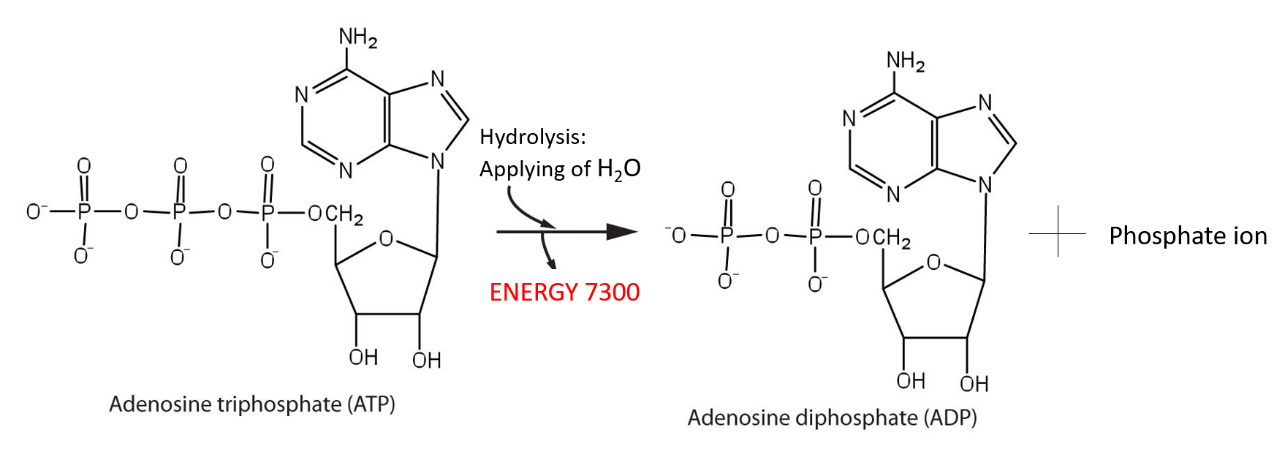
The energy consumed during the conversion of ADP into ATP is
A. 73000 cal/mole
B. 686000 cal/mole
C. 8000 cal/mole
D. 7300 cal/mole
Answer
574.5k+ views
Hint: The conversion form of ATP from ADP is as follows:

Complete answer: Adenosine triphosphate or ATP is a derivative of adenine ring, pentose sugar i.e. ribose, and three phosphate groups.
Adenosine diphosphate or ADP is a derivative of adenine ring, pentose sugar i.e. ribose, and two phosphate groups.
ATP is synthesized in the body by an electron transport chain or ETC with the help of an enzyme called ATP synthase.
Hydrolysis of ATP produces one molecule of ADP and an inorganic phosphate.
Further, upon hydrolysis, one molecule of ADP gives rise to one molecule of AMP or Adenosine monophosphate and one pyrophosphate.
AMP contains an adenine ring, a pentose sugar i.e. ribose, and a phosphate group.
Hydrolysis of ATP generates 7300 calories of energy per mole.
Additional information: 1. ATP is the energy currency of our bodies.
2. ETC takes place in the inner mitochondrial membrane.
3. ATP is a very high energy-yielding molecule.
4. ATP helps to do all the activities that are performed by a human body.
5. It helps in the metabolism, as well as all the chemical reactions that take place inside the body.
So, the correct answer is option D. 7300 cal/mole.
Note: ATP is a nucleotide that is used as a coenzyme inside the cells. ATP is called the "molecular unit of currency". ATP helps to transport chemical energy within cells that are used for metabolism. Every cell uses ATP as energy for functioning.
As the name suggests, ATP is made up of an adenine nitrogen base and three phosphate groups.

Complete answer: Adenosine triphosphate or ATP is a derivative of adenine ring, pentose sugar i.e. ribose, and three phosphate groups.
Adenosine diphosphate or ADP is a derivative of adenine ring, pentose sugar i.e. ribose, and two phosphate groups.
ATP is synthesized in the body by an electron transport chain or ETC with the help of an enzyme called ATP synthase.
Hydrolysis of ATP produces one molecule of ADP and an inorganic phosphate.
Further, upon hydrolysis, one molecule of ADP gives rise to one molecule of AMP or Adenosine monophosphate and one pyrophosphate.
AMP contains an adenine ring, a pentose sugar i.e. ribose, and a phosphate group.
Hydrolysis of ATP generates 7300 calories of energy per mole.
Additional information: 1. ATP is the energy currency of our bodies.
2. ETC takes place in the inner mitochondrial membrane.
3. ATP is a very high energy-yielding molecule.
4. ATP helps to do all the activities that are performed by a human body.
5. It helps in the metabolism, as well as all the chemical reactions that take place inside the body.
So, the correct answer is option D. 7300 cal/mole.
Note: ATP is a nucleotide that is used as a coenzyme inside the cells. ATP is called the "molecular unit of currency". ATP helps to transport chemical energy within cells that are used for metabolism. Every cell uses ATP as energy for functioning.
As the name suggests, ATP is made up of an adenine nitrogen base and three phosphate groups.
Recently Updated Pages
Why is there a time difference of about 5 hours between class 10 social science CBSE

In cricket, what is a "pink ball" primarily used for?

In cricket, what is the "new ball" phase?

In cricket, what is a "death over"?

What is the "Powerplay" in T20 cricket?

In cricket, what is a "super over"?

Trending doubts
What is meant by exothermic and endothermic reactions class 11 chemistry CBSE

Which animal has three hearts class 11 biology CBSE

10 examples of friction in our daily life

One Metric ton is equal to kg A 10000 B 1000 C 100 class 11 physics CBSE

1 Quintal is equal to a 110 kg b 10 kg c 100kg d 1000 class 11 physics CBSE

Difference Between Prokaryotic Cells and Eukaryotic Cells




